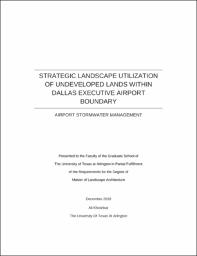
ATTENTION: The works hosted here are being migrated to a new repository that will consolidate resources, improve discoverability, and better show UTA's research impact on the global community. We will update authors as the migration progresses. Please see MavMatrix for more information.
Show simple item record
| dc.contributor.advisor | Im, Joowon | |
| dc.creator | Khoshkar, Ali | |
| dc.date.accessioned | 2019-02-26T20:44:08Z | |
| dc.date.available | 2019-02-26T20:44:08Z | |
| dc.date.created | 2018-12 | |
| dc.date.issued | 2018-12-10 | |
| dc.date.submitted | December 2018 | |
| dc.identifier.uri | http://hdl.handle.net/10106/27764 | |
| dc.description.abstract | The purpose of this research is to investigate and propose a sustainable stormwater management improvement for the Dallas Executive Airport future master plan development while carefully considering wildlife preservation and the beautification of the new facility. The literature review draws upon documented research that global aviation growth causes increasing environmental issues. An in-depth review of the history of the airport’s environmental impact shows an increasing concern which ultimately lead to the assigned regulations.
The research dives into existing environmental issues caused by air transportation, focusing specifically on stormwater pollutions at small airports and the applicable solutions within the airport boundary to mitigate the negative environmental impacts on site. Taking the approach to aviation environmental problems as a Landscape Architect, mapping, GIS data analysis and technical calculations are the effective methodologies to find the most suitable design solution. The comparison between the existing conditions and the future master plan development increases the importance of the consideration of a strategized stormwater management system. The analysis shows that the new development increases the amount of impervious surfaces on site which will eventually increase the amount of run-off that carries pollution to the existing water system and threatens the eco-system of North Central Texas region.
In conclusion this thesis provides airport managers, landscape architects, and stormwater specialists with a suitable design solution that can mitigate the amount of stormwater run-off and pollution by employing a bio-filtration swale to respond to the future master plan of the Dallas Executive Airport. The design of the best management practice (BMP) includes two major features. The first feature involves preserving the existing forested lands with a potential hiking trail for the members of adjacent communities and the second involves the employment of an innovative and efficient bio-filtration swale with sufficient capacity to detain and filter stormwater from existing runways and the future development. | |
| dc.format.mimetype | application/pdf | |
| dc.language.iso | en_US | |
| dc.subject | Landscape architecture | |
| dc.subject | Stormwater management | |
| dc.subject | Landscape planning | |
| dc.subject | Airports | |
| dc.title | STRATEGIC LANDSCAPE UTILIZATION OF UNDEVELOPED LANDS WITHIN DALLAS EXECUTIVE AIRPORT BOUNDARY: AIRPORT STORMWATER MANAGEMENT | |
| dc.type | Thesis | |
| dc.degree.department | Landscape Architecture | |
| dc.degree.name | Master of Landscape Architecture | |
| dc.date.updated | 2019-02-26T20:44:09Z | |
| thesis.degree.department | Landscape Architecture | |
| thesis.degree.grantor | The University of Texas at Arlington | |
| thesis.degree.level | Masters | |
| thesis.degree.name | Master of Landscape Architecture | |
| dc.type.material | text | |
Files in this item
- Name:
- KHOSHKAR-THESIS-2018.pdf
- Size:
- 5.240Mb
- Format:
- PDF
This item appears in the following Collection(s)
Show simple item record


